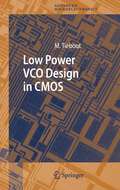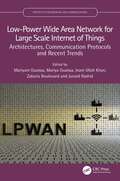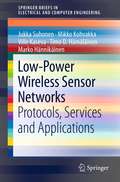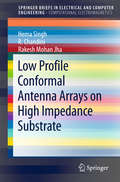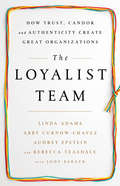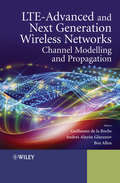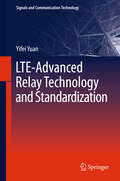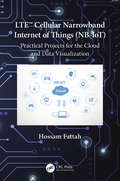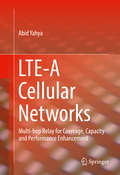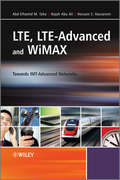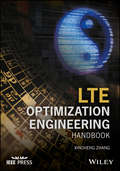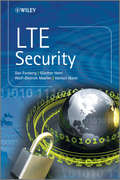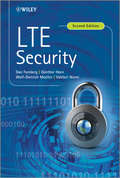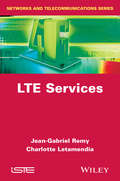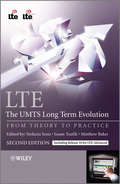- Table View
- List View
Low Power VCO Design in CMOS (Springer Series in Advanced Microelectronics #20)
by Marc TieboutThis work covers the design of CMOS fully integrated low power low phase noise voltage controlled oscillators for telecommunication or datacommuni- tion systems. The need for low power is obvious, as mobile wireless telecommunications are battery operated. As wireless telecommunication systems use oscillators in frequency synthesizers for frequency translation, the selectivity and signal to noise ratio of receivers and transmitters depend heavily on the low phase noise performance of the implemented oscillators. Datacommunication s- tems need low jitter, the time-domain equivalent of low phase noise, clocks for data detection and recovery. The power consumption is less critical. The need for multi-band and multi-mode systems pushes the high-integration of telecommunication systems. This is o?ered by sub-micron CMOS feat- ing digital ?exibility. The recent crisis in telecommunication clearly shows that mobile hand-sets became mass-market high-volume consumer products, where low-cost is of prime importance. This need for low-cost products - livens tremendously research towards CMOS alternatives for the bipolar or BiCMOS solutions in use today.
Low-Power Wide Area Network for Large Scale Internet of Things: Architectures, Communication Protocols and Recent Trends (Prospects in Networking and Communications – P-NetCom)
by Mariyam Ouaissa Mariya Ouaissa Inam Ullah Khan Zakaria Boulouard Junaid RashidThis book presents a comprehensive exploration of LPWANs, delving into their fundamental concepts, underlying technologies, and the multifaceted challenges they tackle. This book recognizes that LPWANs don't operate in isolation; they are intimately intertwined with Artificial Intelligence and Machine Learning (AI/ML) technologies, which play a pivotal role in optimizing LPWAN performance and capabilities. The book is a collection of original contributions regarding air interface, transmission technologies and novel network architectures, such as network slicing, cloud/fog/edge computing, ad hoc networks and software-defined network. Also, this book provides a guide for researchers of IoT applications to choose suitable LPWAN technologies and describe the design aspects, network architectures, security issues and challenges.Features: Explains machine learning algorithms onto low-power wide area network sensors for compressed communications. Illustrates wireless-based Internet of Things networks using low-power wide area networks technology for quality air. Presents cognitive Internet of Things networks using wireless communication, and low-power wide area network technologies for Ad Hoc networks. Discusses a comprehensive study of low-power wide area networks for flying Ad Hoc networks. Showcases the study of energy efficient techniques aided by low-power wide area network technologies for the Internet of Things networks. The text is aimed at senior undergraduate, graduate students, and academic researchers in the fields of electrical engineering, electronics and communication engineering, computer engineering, and information technology.
Low-Power Wide Area Network for Large Scale Internet of Things: Architectures, Communication Protocols and Recent Trends (Prospects in Networking and Communications – P-NetCom)
This book presents a comprehensive exploration of LPWANs, delving into their fundamental concepts, underlying technologies, and the multifaceted challenges they tackle. This book recognizes that LPWANs don't operate in isolation; they are intimately intertwined with Artificial Intelligence and Machine Learning (AI/ML) technologies, which play a pivotal role in optimizing LPWAN performance and capabilities. The book is a collection of original contributions regarding air interface, transmission technologies and novel network architectures, such as network slicing, cloud/fog/edge computing, ad hoc networks and software-defined network. Also, this book provides a guide for researchers of IoT applications to choose suitable LPWAN technologies and describe the design aspects, network architectures, security issues and challenges.Features: Explains machine learning algorithms onto low-power wide area network sensors for compressed communications. Illustrates wireless-based Internet of Things networks using low-power wide area networks technology for quality air. Presents cognitive Internet of Things networks using wireless communication, and low-power wide area network technologies for Ad Hoc networks. Discusses a comprehensive study of low-power wide area networks for flying Ad Hoc networks. Showcases the study of energy efficient techniques aided by low-power wide area network technologies for the Internet of Things networks. The text is aimed at senior undergraduate, graduate students, and academic researchers in the fields of electrical engineering, electronics and communication engineering, computer engineering, and information technology.
Low-Power Wireless Sensor Networks: Protocols, Services and Applications (SpringerBriefs in Electrical and Computer Engineering)
by Jukka Suhonen Mikko Kohvakka Ville Kaseva Timo D. Hämäläinen Marko HännikäinenWireless sensor network (WSN) is an ad-hoc network technology comprising even thousands of autonomic and self-organizing nodes that combine environmental sensing, data processing, and wireless networking. The applications for sensor networks range from home and industrial environments to military uses. Unlike the traditional computer networks, a WSN is application-oriented and deployed for a specific task. WSNs are data centric, which means that messages are not send to individual nodes but to geographical locations or regions based on the data content. A WSN node is typically battery powered and characterized by extremely small size and low cost. As a result, the processing power, memory, and energy resources of an individual sensor node are limited. However, the feasibility of a WSN lies on the collaboration between the nodes. A reference WSN node comprises a Micro-Controller Unit (MCU) having few Million Instructions Per Second (MIPS) processing speed, tens of kilobytes program memory, few kilobytes data memory. In addition, the node contains a short-range radio, and a set of sensors. Supply power is typically obtained with small batteries. Assuming a target lifetime of one year using AA-size batteries, the available power budget is around 1 mW. This book covers the low-power WSNs services ranging from hardware platforms and communication protocols to network deployment, and sensor data collection and actuation. The implications of resource constraints and expected performance in terms of throughput, reliability and latency are explained. As a case study, this book presents experiments with low-energy TUTWSN technology to illustrate the possibilities and limitations of WSN applications.
Low Profile Conformal Antenna Arrays on High Impedance Substrate (SpringerBriefs in Electrical and Computer Engineering)
by Hema Singh R. Chandini Rakesh Mohan JhaThis book presents electromagnetic (EM) design and analysis of dipole antenna array over high impedance substrate (HIS). HIS is a preferred substrate for low-profile antenna design, owing to its unique boundary conditions. Such substrates permit radiating elements to be printed on them without any disturbance in the radiation characteristics. Moreover HIS provides improved impedance matching, enhanced bandwidth, and increased broadside directivity owing to total reflection from the reactive surface and high input impedance. This book considers different configurations of HIS for array design on planar and non-planar high-impedance surfaces. Results are presented for cylindrical dipole, printed dipole, and folded dipole over single- and double-layered square-patch-based HIS and dogbone-based HIS. The performance of antenna arrays is analyzed in terms of performance parameters such as return loss and radiation pattern. The design presented shows acceptable return loss and mainlobe gain of radiation pattern. This book provides an insight to EM design and analysis of conformal arrays. This book serves as an introduction for beginners in the design and analysis of HIS-based antenna arrays. It includes pictorial description of both planar and non-planar array design and the detailed discussion of the performance analysis of HIS-based planar and non-planar antenna array. It will prove useful to researchers and professionals, alike.
The Loyalist Team: How Trust, Candor, and Authenticity Create Great Organizations
by Linda Adams Abby Curnow-Chavez Audrey Epstein Rebecca TeasdaleGreat teams are built and maintained with great intention, though they can make it look deceptively easy. Too many teams engage in dysfunctional behaviors or fall into territorialism, apathy, and unproductive relationships. The result? An overwhelmed, unengaged, and stressed-out workforce that settles for average or poor performance.Here, four authors with a combined century of management experience show readers how every team can be extraordinary. The authors introduce their field-tested Loyalist Team 3D assessment that allows anyone to get to the heart of why teams break down, identify the weaknesses in their own team, and build a Loyalist Team. This kind of team has members who ensure each other's success as they work to ensure their own, operate with absolute candor, and value loyalty and authenticity to deliver results, create a healthy work environment, and help companies succeed. The Loyalist Team is a must-read for anyone who wants their team to achieve extraordinary results.
The Loyalist Team: How Trust, Candor, and Authenticity Create Great Organizations
by Linda Adams Abby Curnow-Chavez Audrey Epstein Rebecca TeasdaleGreat teams are built and maintained with great intention, though they can make it look deceptively easy. Too many teams engage in dysfunctional behaviors or fall into territorialism, apathy, and unproductive relationships. The result? An overwhelmed, unengaged, and stressed-out workforce that settles for average or poor performance. Here, four authors with a combined century of management experience show readers how every team can be extraordinary. The authors introduce their field-tested Loyalist Team 3D assessment that allows anyone to get to the heart of why teams break down, identify the weaknesses in their own team, and build a Loyalist Team. This kind of team has members who ensure each other's success as they work to ensure their own, operate with absolute candor, and value loyalty and authenticity to deliver results, create a healthy work environment, and help companies succeed. The Loyalist Team is a must-read for anyone who wants their team to achieve extraordinary results.
LTE-Advanced and Next Generation Wireless Networks: Channel Modelling and Propagation
by Guillaume de la Roche Andrés Alayón-Glazunov Ben AllenLTE- A and Next Generation Wireless Networks: Channel Modeling and Performance describes recent advances in propagation and channel modeling necessary for simulating next generation wireless systems. Due to the radio spectrum scarcity, two fundamental changes are anticipated compared to the current status. Firstly, the strict reservation of a specific band for a unique standard could evolve toward a priority policy allowing the co-existence of secondary users in a band allocated to a primary system. Secondly, a huge increase of the number of cells is expected by combining outdoor base stations with smaller cells such as pico/femto cells and relays. This evolution is accompanied with the emergence of cognitive radio that becomes a reality in terminals together with the development of self-organization capabilities and distributed cooperative behaviors. The book is divided into three parts: Part I addresses the fundamentals (e.g. technologies, channel modeling principles etc.) Part II addresses propagation and modeling discussing topics such as indoor propagation, outdoor propagation, etc. Part III explores system performance and applications (e.g. MIMO Over-the-air testing, electromagnetic safety, etc).
LTE-Advanced and Next Generation Wireless Networks: Channel Modelling and Propagation
by Guillaume de la Roche Andrés Alayón-Glazunov Ben AllenLTE- A and Next Generation Wireless Networks: Channel Modeling and Performance describes recent advances in propagation and channel modeling necessary for simulating next generation wireless systems. Due to the radio spectrum scarcity, two fundamental changes are anticipated compared to the current status. Firstly, the strict reservation of a specific band for a unique standard could evolve toward a priority policy allowing the co-existence of secondary users in a band allocated to a primary system. Secondly, a huge increase of the number of cells is expected by combining outdoor base stations with smaller cells such as pico/femto cells and relays. This evolution is accompanied with the emergence of cognitive radio that becomes a reality in terminals together with the development of self-organization capabilities and distributed cooperative behaviors. The book is divided into three parts: Part I addresses the fundamentals (e.g. technologies, channel modeling principles etc.) Part II addresses propagation and modeling discussing topics such as indoor propagation, outdoor propagation, etc. Part III explores system performance and applications (e.g. MIMO Over-the-air testing, electromagnetic safety, etc).
LTE-Advanced Relay Technology and Standardization (Signals and Communication Technology)
by Yifei YuanLTE-Advanced relay technology and standardization provides a timely reference work for relay technology with the finalizing of LTE Release 10 specifications. LTE-Advanced is quickly becoming the global standard for 4G cellular communications. The relay technology, as one of the key features in LTE-Advanced, helps not only to improve the system coverage and capacity, but also to save the costs of laying wireline backhaul. As a leading researcher in the field of LTE-Advanced standards, the author provides an in-depth description of LTE-A relay technology, and explains in detail the standard specification and design principles. Readers from both academic and industrial fields can find sections of interest to them: Sections 2 & 4 could benefit researchers in academia and those who are engaged in exploratory work, while Sections 3 & 4 are more useful to engineers. Dr. Yifei Yuan is the Technical Director at the Standards Department of ZTE Inc.
LTE Cellular Narrowband Internet of Things (NB-IoT): Practical Projects for the Cloud and Data Visualization
by Hossam FattahNB-IoT is the Internet of Things (IoT) technology used for cellular communication. NB-IoT devices deliver much better capability and performance, such as: increased area coverage of up to one kilometer; a massive number of devices—up to 200,000—per a single base-station area; longer battery lifetime of ten years; and better indoor and outdoor coverage for areas with weak signal, such as underground garages. The cellular NB-IoT technology is a challenging technology to use and understand. With more than 30 projects presented in this book, covering many use cases and scenarios, this book provides hands-on and practical experience of how to use the cellular NB-IoT for smart applications using Arduino™, Amazon Cloud, Google Maps, and charts. The book starts by explaining AT commands used to configure the NB-IoT modem; data serialization and deserialization; how to set up the cloud for connecting NB-IoT devices; setting up rules, policy, security certificates, and a NoSQL database on the cloud; how to store and read data in the cloud; how to use Google Maps to visualize NB-IoT device geo-location; and how to use charts to visualize sensor datasets. Projects for Arduino are presented in four parts. The first part explains how to connect the device to the mobile operator and cellular network; perform communication using different network protocols, such as TCP, HTTP, SSL, or MQTT; how to use GPS for geo-location applications; and how to upgrade NB-IoT modem firmware over the air. The second part explains the microcontroller unit and how to build and run projects, such as a 7-segment display or a real-time clock. The third part explains how NB-IoT can be used with sensor devices, such as ultrasonic and environmental sensors. Finally, the fourth part explains how NB-IoT can be used to control actuators, such as stepper motors and relays. This book is a unique resource for understanding practical uses of the NB-IoT technology and serves as a handbook for technical and non-technical readers who are looking for practicing and exercising the cellular NB-IoT technology. The book can be used by engineers, students, researchers, system integrators, mobile operators’ technical staff, and electronics enthusiasts. To download the software which can be used with the book, go to: https://github.com/5ghub/NB-IoT About the Author: Hossam Fattah is a technology expert in 4G/5G wireless systems and networking. He received his Ph.D. in Electrical and Computer Engineering from University of British Columbia, Vancouver, Canada in 2003. He received his Master of Applied Science in Electrical and Computer Engineering from University of Victoria, Victoria, Canada in 2000. He completed his B.Sc. degree in Computers and Systems Engineering from Al-Azhar University, Cairo, Egypt in 1995. Between 2003 and 2011, he was in academia and industry, including Texas A&M University. Between 2011 and 2013, he was with Spirent Communications, NJ, USA. Since 2013, he has been with Microsoft, USA. He is also an affiliate associate professor at University of Washington, Tacoma, WA, USA, teaching graduate courses on IoT and distributed systems and collaborating on 5G research and innovations. He has had many patents and technical publications in conferences and journals. He is a registered professional Engineer with the Association of Professional Engineers, British Columbia, Canada. He is the author of the recent book 5G LTE Narrowband Internet of Things (NB-IoT). His research interest is in wireless communications and radio networks and protocols, cellular quality of service, radio resource management, traffic and packet scheduling, network analytics, and mobility.
LTE Cellular Narrowband Internet of Things (NB-IoT): Practical Projects for the Cloud and Data Visualization
by Hossam FattahNB-IoT is the Internet of Things (IoT) technology used for cellular communication. NB-IoT devices deliver much better capability and performance, such as: increased area coverage of up to one kilometer; a massive number of devices—up to 200,000—per a single base-station area; longer battery lifetime of ten years; and better indoor and outdoor coverage for areas with weak signal, such as underground garages. The cellular NB-IoT technology is a challenging technology to use and understand. With more than 30 projects presented in this book, covering many use cases and scenarios, this book provides hands-on and practical experience of how to use the cellular NB-IoT for smart applications using Arduino™, Amazon Cloud, Google Maps, and charts. The book starts by explaining AT commands used to configure the NB-IoT modem; data serialization and deserialization; how to set up the cloud for connecting NB-IoT devices; setting up rules, policy, security certificates, and a NoSQL database on the cloud; how to store and read data in the cloud; how to use Google Maps to visualize NB-IoT device geo-location; and how to use charts to visualize sensor datasets. Projects for Arduino are presented in four parts. The first part explains how to connect the device to the mobile operator and cellular network; perform communication using different network protocols, such as TCP, HTTP, SSL, or MQTT; how to use GPS for geo-location applications; and how to upgrade NB-IoT modem firmware over the air. The second part explains the microcontroller unit and how to build and run projects, such as a 7-segment display or a real-time clock. The third part explains how NB-IoT can be used with sensor devices, such as ultrasonic and environmental sensors. Finally, the fourth part explains how NB-IoT can be used to control actuators, such as stepper motors and relays. This book is a unique resource for understanding practical uses of the NB-IoT technology and serves as a handbook for technical and non-technical readers who are looking for practicing and exercising the cellular NB-IoT technology. The book can be used by engineers, students, researchers, system integrators, mobile operators’ technical staff, and electronics enthusiasts. To download the software which can be used with the book, go to: https://github.com/5ghub/NB-IoT About the Author: Hossam Fattah is a technology expert in 4G/5G wireless systems and networking. He received his Ph.D. in Electrical and Computer Engineering from University of British Columbia, Vancouver, Canada in 2003. He received his Master of Applied Science in Electrical and Computer Engineering from University of Victoria, Victoria, Canada in 2000. He completed his B.Sc. degree in Computers and Systems Engineering from Al-Azhar University, Cairo, Egypt in 1995. Between 2003 and 2011, he was in academia and industry, including Texas A&M University. Between 2011 and 2013, he was with Spirent Communications, NJ, USA. Since 2013, he has been with Microsoft, USA. He is also an affiliate associate professor at University of Washington, Tacoma, WA, USA, teaching graduate courses on IoT and distributed systems and collaborating on 5G research and innovations. He has had many patents and technical publications in conferences and journals. He is a registered professional Engineer with the Association of Professional Engineers, British Columbia, Canada. He is the author of the recent book 5G LTE Narrowband Internet of Things (NB-IoT). His research interest is in wireless communications and radio networks and protocols, cellular quality of service, radio resource management, traffic and packet scheduling, network analytics, and mobility.
LTE-A Cellular Networks: Multi-hop Relay for Coverage, Capacity and Performance Enhancement
by Abid YahyaIn this book, three different methods are presented to enhance the capacity and coverage area in LTE-A cellular networks. The scope involves the evaluation of the effect of the RN location in terms of capacity and the determination of the optimum location of the relay that provides maximum achievable data rate for users with limited interference at the cell boundaries. This book presents a new model to enhance both capacity and coverage area in LTE-A cellular network by determining the optimum location for the RN with limited interference. The new model is designed to enhance the capacity of the relay link by employing two antennas in RN. This design enables the relay link to absorb more users at cell edge regions. An algorithm called the Balance Power Algorithm (BPA) is developed to reduce MR power consumption. The book pertains to postgraduate students and researchers in wireless & mobile communications.
LTE, LTE-Advanced and WiMAX: Towards IMT-Advanced Networks
by Abd-Elhamid M. Taha Najah Abu Ali Hossam S. HassaneinA concise introduction to IMT-Advanced Systems, including LTE-Advanced and WiMAX There exists a strong demand for fully extending emerging Internet services, including collaborative applications and social networking, to the mobile and wireless domain. Delivering such services can be possible only through realizing broadband in the wireless. Two candidate technologies are currently competing in fulfilling the requirements for wireless broadband networks, WiMAX and LTE. At the moment, LTE and its future evolution LTE-Advanced are already gaining ground in terms of vendor and operator support. Whilst both technologies share certain attributes (utilizing Orthogonal Frequency Division Multiple Access (OFDMA) in downlink, accommodating smart antennas and full support for IP-switching, for example), they differ in others (including uplink technology, scheduling, frame structure and mobility support). Beyond technological merits, factors such as deployment readiness, ecosystem maturity and migration feasibility come to light when comparing the aptitude of the two technologies. LTE, LTE-Advanced and WiMAX: Towards IMT-Advanced Networks provides a concise, no-nonsense introduction to the two technologies, covering both interface and networking considerations. More critically, the book gives a multi-faceted comparison, carefully analyzing and distinguishing the characteristics of each technology and spanning both technical and economic merits. A “big picture” understanding of the market strategies and forecasts is also offered. Discusses and critically evaluates LTE, LTE-Advanced and WiMAX (Legacy and Advanced) Gives an overview of the principles and advances of each enabling technology Offers a feature-by-feature comparison between the candidate technologies Includes information which appeals to both industry practitioners and academics Provides an up-to-date report on market and industry status
LTE, LTE-Advanced and WiMAX: Towards IMT-Advanced Networks
by Abd-Elhamid M. Taha Najah Abu Ali Hossam S. HassaneinA concise introduction to IMT-Advanced Systems, including LTE-Advanced and WiMAX There exists a strong demand for fully extending emerging Internet services, including collaborative applications and social networking, to the mobile and wireless domain. Delivering such services can be possible only through realizing broadband in the wireless. Two candidate technologies are currently competing in fulfilling the requirements for wireless broadband networks, WiMAX and LTE. At the moment, LTE and its future evolution LTE-Advanced are already gaining ground in terms of vendor and operator support. Whilst both technologies share certain attributes (utilizing Orthogonal Frequency Division Multiple Access (OFDMA) in downlink, accommodating smart antennas and full support for IP-switching, for example), they differ in others (including uplink technology, scheduling, frame structure and mobility support). Beyond technological merits, factors such as deployment readiness, ecosystem maturity and migration feasibility come to light when comparing the aptitude of the two technologies. LTE, LTE-Advanced and WiMAX: Towards IMT-Advanced Networks provides a concise, no-nonsense introduction to the two technologies, covering both interface and networking considerations. More critically, the book gives a multi-faceted comparison, carefully analyzing and distinguishing the characteristics of each technology and spanning both technical and economic merits. A “big picture” understanding of the market strategies and forecasts is also offered. Discusses and critically evaluates LTE, LTE-Advanced and WiMAX (Legacy and Advanced) Gives an overview of the principles and advances of each enabling technology Offers a feature-by-feature comparison between the candidate technologies Includes information which appeals to both industry practitioners and academics Provides an up-to-date report on market and industry status
LTE Optimization Engineering Handbook
by Xincheng ZhangA comprehensive resource containing the operating principles and key insights of LTE networks performance optimization LTE Optimization Engineering Handbook is a comprehensive reference that describes the most current technologies and optimization principles for LTE networks. The text offers an introduction to the basics of LTE architecture, services and technologies and includes details on the key principles and methods of LTE optimization and its parameters. In addition, the author clarifies different optimization aspects such as wireless channel optimization, data optimization, CSFB, VoLTE, and video optimization. With the ubiquitous usage and increased development of mobile networks and smart devices, LTE is the 4G network that will be the only mainstream technology in the current mobile communication system and in the near future. Designed for use by researchers, engineers and operators working in the field of mobile communications and written by a noted engineer and experienced researcher, the LTE Optimization Engineering Handbook provides an essential guide that: Discusses the latest optimization engineering technologies of LTE networks and explores their implementation Features the latest and most industrially relevant applications, such as VoLTE and HetNets Includes a wealth of detailed scenarios and optimization real-world case studies Professionals in the field will find the LTE Optimization Engineering Handbook to be their go-to reference that includes a thorough and complete examination of LTE networks, their operating principles, and the most current information to performance optimization.
LTE Optimization Engineering Handbook
by Xincheng ZhangA comprehensive resource containing the operating principles and key insights of LTE networks performance optimization LTE Optimization Engineering Handbook is a comprehensive reference that describes the most current technologies and optimization principles for LTE networks. The text offers an introduction to the basics of LTE architecture, services and technologies and includes details on the key principles and methods of LTE optimization and its parameters. In addition, the author clarifies different optimization aspects such as wireless channel optimization, data optimization, CSFB, VoLTE, and video optimization. With the ubiquitous usage and increased development of mobile networks and smart devices, LTE is the 4G network that will be the only mainstream technology in the current mobile communication system and in the near future. Designed for use by researchers, engineers and operators working in the field of mobile communications and written by a noted engineer and experienced researcher, the LTE Optimization Engineering Handbook provides an essential guide that: Discusses the latest optimization engineering technologies of LTE networks and explores their implementation Features the latest and most industrially relevant applications, such as VoLTE and HetNets Includes a wealth of detailed scenarios and optimization real-world case studies Professionals in the field will find the LTE Optimization Engineering Handbook to be their go-to reference that includes a thorough and complete examination of LTE networks, their operating principles, and the most current information to performance optimization.
LTE Security (Nsn/nokia Ser. #1)
by Dan Forsberg Günther Horn Wolf-Dietrich Moeller Valtteri NiemiAddressing the security solutions for LTE, a cellular technology from Third Generation Partnership Project (3GPP), this book shows how LTE security substantially extends GSM and 3G security. It also encompasses the architectural aspects, known as SAE, to give a comprehensive resource on the topic. Although the security for SAE/LTE evolved from the security for GSM and 3G, due to different architectural and business requirements of fourth generation systems the SAE/LTE security architecture is substantially different from its predecessors. This book presents in detail the security mechanisms employed to meet these requirements. Whilst the industry standards inform how to implement systems, they do not provide readers with the underlying principles behind security specifications. LTE Security fills this gap by providing first hand information from 3GPP insiders who explain the rationale for design decisions. Key features: Provides a concise guide to the 3GPP/LTE Security Standardization specifications Authors are leading experts who participated in decisively shaping SAE/LTE security in the relevant standardization body, 3GPP Shows how GSM and 3G security was enhanced and extended to meet the requirements of fourth generation systems Gives the rationale behind the standards specifications enabling readers to have a broader understanding of the context of these specifications Explains why LTE security solutions are designed as they are and how theoretical security mechanisms can be put to practical use
LTE Security
by Dan Forsberg Günther Horn Wolf-Dietrich Moeller Valtteri NiemiAddressing the security solutions for LTE, a cellular technology from Third Generation Partnership Project (3GPP), this book shows how LTE security substantially extends GSM and 3G security. It also encompasses the architectural aspects, known as SAE, to give a comprehensive resource on the topic. Although the security for SAE/LTE evolved from the security for GSM and 3G, due to different architectural and business requirements of fourth generation systems the SAE/LTE security architecture is substantially different from its predecessors. This book presents in detail the security mechanisms employed to meet these requirements. Whilst the industry standards inform how to implement systems, they do not provide readers with the underlying principles behind security specifications. LTE Security fills this gap by providing first hand information from 3GPP insiders who explain the rationale for design decisions. Key features: Provides a concise guide to the 3GPP/LTE Security Standardization specifications Authors are leading experts who participated in decisively shaping SAE/LTE security in the relevant standardization body, 3GPP Shows how GSM and 3G security was enhanced and extended to meet the requirements of fourth generation systems Gives the rationale behind the standards specifications enabling readers to have a broader understanding of the context of these specifications Explains why LTE security solutions are designed as they are and how theoretical security mechanisms can be put to practical use
LTE Security (NSN/Nokia Series #1)
by Dan Forsberg Günther Horn Wolf-Dietrich Moeller Valtteri NiemiA concise, updated guide to the 3GPP LTE Security Standardization specifications A welcome Revised Edition of the successful LTE Security addressing the security architecture for SAE/LTE, which is based on elements of the security architectures for GSM and 3G, but which needed a major redesign due to the significantly increased complexity, and different architectural and business requirements of fourth generation systems. The authors explain in detail the security mechanisms employed to meet these requirements. The specifications generated by standardization bodies only inform about how to implement the system (and this only to the extent required for interoperability), but almost never inform readers about why things are done the way they are. Furthermore, specifications tend to be readable only for a small group of experts and lack the context of the broader picture. The book fills this gap by providing first hand information from insiders who participated in decisively shaping SAE/LTE security in the relevant standardization body, 3GPP, and can therefore explain the rationale for design decisions in this area. A concise, fully updated guide to the 3GPP LTE Security Standardization specifications Describes the essential elements of LTE and SAE Security, written by leading experts who participated in decisively shaping SAE/LTE security in the relevant standardization body, 3GPP Explains the rationale behind the standards specifications giving readers a broader understanding of the context to these specifications Includes new chapters covering 3GPP work on system enhancements for MTC, plus application layer security in ETSI TC M2M and embedded smart card in ETSI SCP; Security for Machine-type Communication, Relay Node Security, and Future Challenges, including Voice over LTE, MTC, Home base stations, LIPA/SIPTO, and New Cryptographic Algorithms Essential reading for System engineers, developers and people in technical sales working in the area of LTE and LTE security, communication engineers and software developers in mobile communication field.
LTE Security (NSN/Nokia Series #1)
by Dan Forsberg Günther Horn Wolf-Dietrich Moeller Valtteri NiemiA concise, updated guide to the 3GPP LTE Security Standardization specifications A welcome Revised Edition of the successful LTE Security addressing the security architecture for SAE/LTE, which is based on elements of the security architectures for GSM and 3G, but which needed a major redesign due to the significantly increased complexity, and different architectural and business requirements of fourth generation systems. The authors explain in detail the security mechanisms employed to meet these requirements. The specifications generated by standardization bodies only inform about how to implement the system (and this only to the extent required for interoperability), but almost never inform readers about why things are done the way they are. Furthermore, specifications tend to be readable only for a small group of experts and lack the context of the broader picture. The book fills this gap by providing first hand information from insiders who participated in decisively shaping SAE/LTE security in the relevant standardization body, 3GPP, and can therefore explain the rationale for design decisions in this area. A concise, fully updated guide to the 3GPP LTE Security Standardization specifications Describes the essential elements of LTE and SAE Security, written by leading experts who participated in decisively shaping SAE/LTE security in the relevant standardization body, 3GPP Explains the rationale behind the standards specifications giving readers a broader understanding of the context to these specifications Includes new chapters covering 3GPP work on system enhancements for MTC, plus application layer security in ETSI TC M2M and embedded smart card in ETSI SCP; Security for Machine-type Communication, Relay Node Security, and Future Challenges, including Voice over LTE, MTC, Home base stations, LIPA/SIPTO, and New Cryptographic Algorithms Essential reading for System engineers, developers and people in technical sales working in the area of LTE and LTE security, communication engineers and software developers in mobile communication field.
LTE Services
by Jean-Gabriel Rémy Charlotte LetamendiaLTE (Long Term Evolution) is commonly marketed as 4G. LTE and LTE Advanced have been recognized by ITU-R and ITU-T (International Telecommunications Union – Telecommunications) as the principal solution for the future mobile communication networks standards. They are thus the framework of what the marketing calls 4G and possibly also 5G. This book describes various aspects of LTE as well as the change of paradigm, which it is bringing to mobile communications, focusing on LTE standards and architecture, OFDMA, the Full IP Core Network and LTE security.
LTE Services
by Jean-Gabriel Rémy Charlotte LetamendiaLTE (Long Term Evolution) is commonly marketed as 4G. LTE and LTE Advanced have been recognized by ITU-R and ITU-T (International Telecommunications Union – Telecommunications) as the principal solution for the future mobile communication networks standards. They are thus the framework of what the marketing calls 4G and possibly also 5G. This book describes various aspects of LTE as well as the change of paradigm, which it is bringing to mobile communications, focusing on LTE standards and architecture, OFDMA, the Full IP Core Network and LTE security.
LTE - The UMTS Long Term Evolution: From Theory to Practice
by Stefania Sesia Issam Toufik Matthew Baker"Where this book is exceptional is that the reader will not just learn how LTE works but why it works" Adrian Scrase, ETSI Vice-President, International Partnership Projects Following on the success of the first edition, this book is fully updated, covering the latest additions to LTE and the key features of LTE-Advanced. This book builds on the success of its predecessor, offering the same comprehensive system-level understanding built on explanations of the underlying theory, now expanded to include complete coverage of Release 9 and the developing specifications for LTE-Advanced. The book is a collaborative effort of more than 40 key experts representing over 20 companies actively participating in the development of LTE, as well as academia. The book highlights practical implications, illustrates the expected performance, and draws comparisons with the well-known WCDMA/HSPA standards. The authors not only pay special attention to the physical layer, giving an insight into the fundamental concepts of OFDMA-FDMA and MIMO, but also cover the higher protocol layers and system architecture to enable the reader to gain an overall understanding of the system. Key New Features: Comprehensively updated with the latest changes of the LTE Release 8 specifications, including improved coverage of Radio Resource Management RF aspects and performance requirements Provides detailed coverage of the new LTE Release 9 features, including: eMBMS, dual-layer beamforming, user equipment positioning, home eNodeBs / femtocells and pico cells and self-optimizing networks Evaluates the LTE system performance Introduces LTE-Advanced, explaining its context and motivation, as well as the key new features including: carrier aggregation, relaying, high-order MIMO, and Cooperative Multi-Point transmission (CoMP). Includes an accompanying website containing a complete list of acronyms related to LTE and LTE-Advanced, with a brief description of each (http://www.wiley.com/go/sesia_theumts) This book is an invaluable reference for all research and development engineers involved in implementation of LTE or LTE-Advanced, as well as graduate and PhD students in wireless communications. Network operators, service providers and R&D managers will also find this book insightful.
LTE - The UMTS Long Term Evolution: From Theory to Practice
by Stefania Sesia Issam Toufik Matthew Baker"Where this book is exceptional is that the reader will not just learn how LTE works but why it works" Adrian Scrase, ETSI Vice-President, International Partnership Projects Following on the success of the first edition, this book is fully updated, covering the latest additions to LTE and the key features of LTE-Advanced. This book builds on the success of its predecessor, offering the same comprehensive system-level understanding built on explanations of the underlying theory, now expanded to include complete coverage of Release 9 and the developing specifications for LTE-Advanced. The book is a collaborative effort of more than 40 key experts representing over 20 companies actively participating in the development of LTE, as well as academia. The book highlights practical implications, illustrates the expected performance, and draws comparisons with the well-known WCDMA/HSPA standards. The authors not only pay special attention to the physical layer, giving an insight into the fundamental concepts of OFDMA-FDMA and MIMO, but also cover the higher protocol layers and system architecture to enable the reader to gain an overall understanding of the system. Key New Features: Comprehensively updated with the latest changes of the LTE Release 8 specifications, including improved coverage of Radio Resource Management RF aspects and performance requirements Provides detailed coverage of the new LTE Release 9 features, including: eMBMS, dual-layer beamforming, user equipment positioning, home eNodeBs / femtocells and pico cells and self-optimizing networks Evaluates the LTE system performance Introduces LTE-Advanced, explaining its context and motivation, as well as the key new features including: carrier aggregation, relaying, high-order MIMO, and Cooperative Multi-Point transmission (CoMP). Includes an accompanying website containing a complete list of acronyms related to LTE and LTE-Advanced, with a brief description of each (http://www.wiley.com/go/sesia_theumts) This book is an invaluable reference for all research and development engineers involved in implementation of LTE or LTE-Advanced, as well as graduate and PhD students in wireless communications. Network operators, service providers and R&D managers will also find this book insightful.
